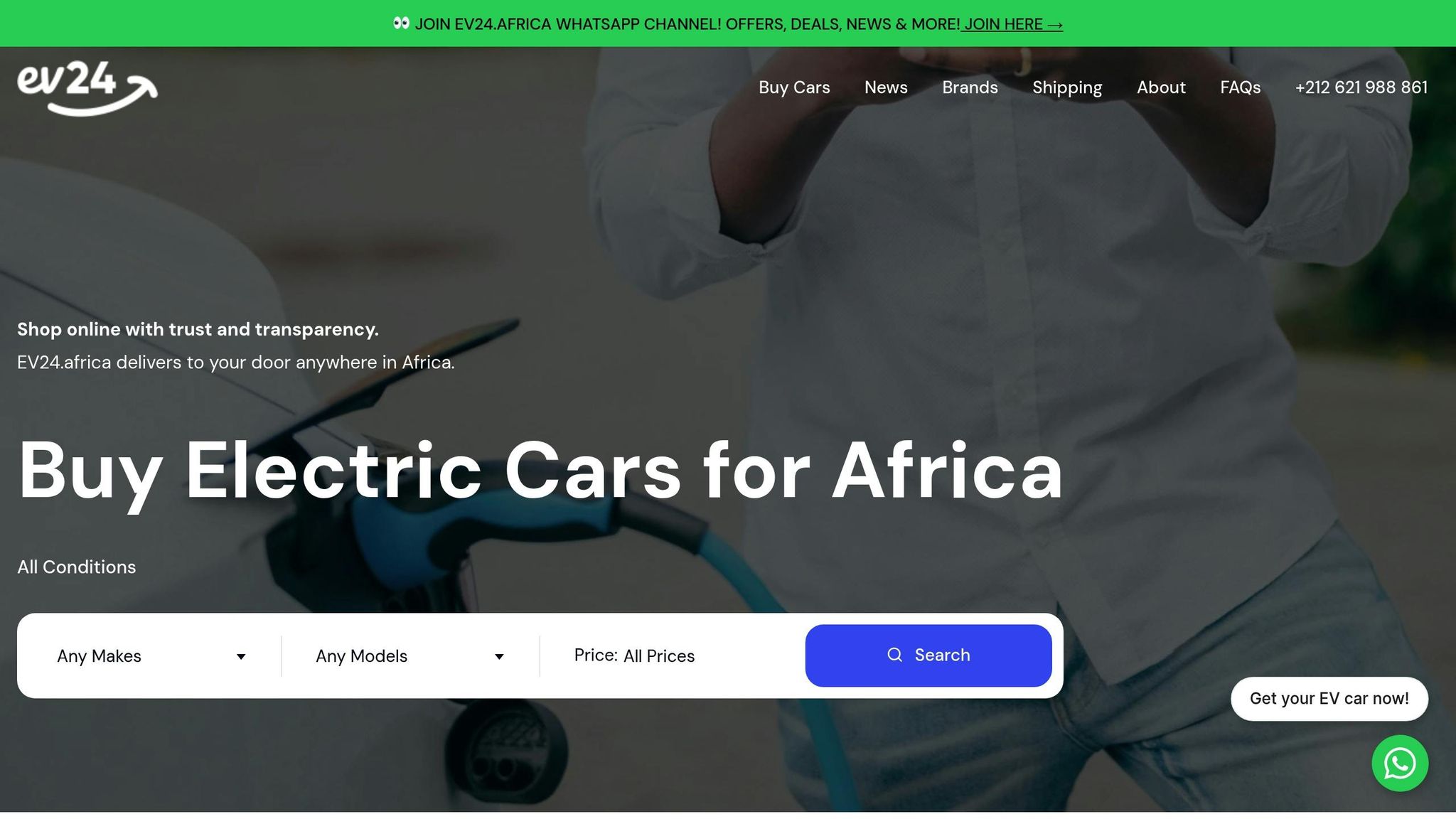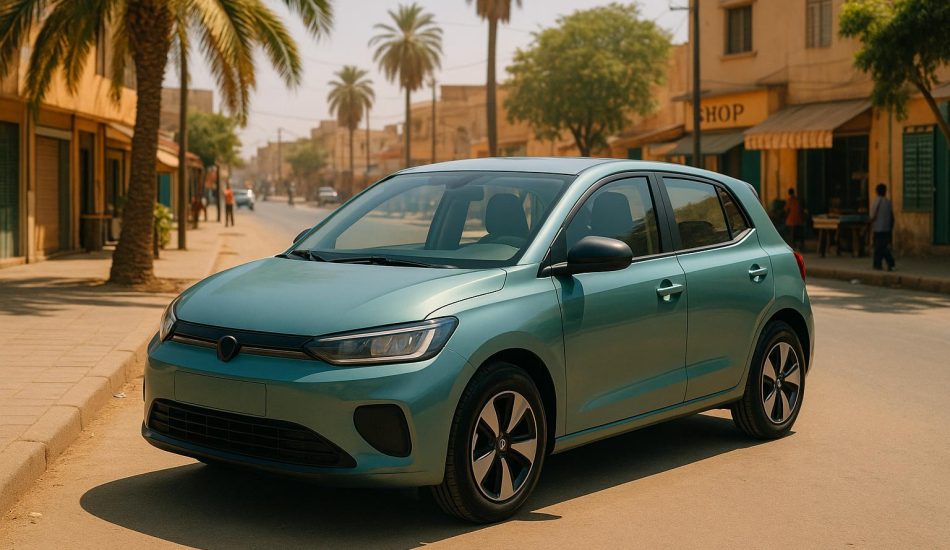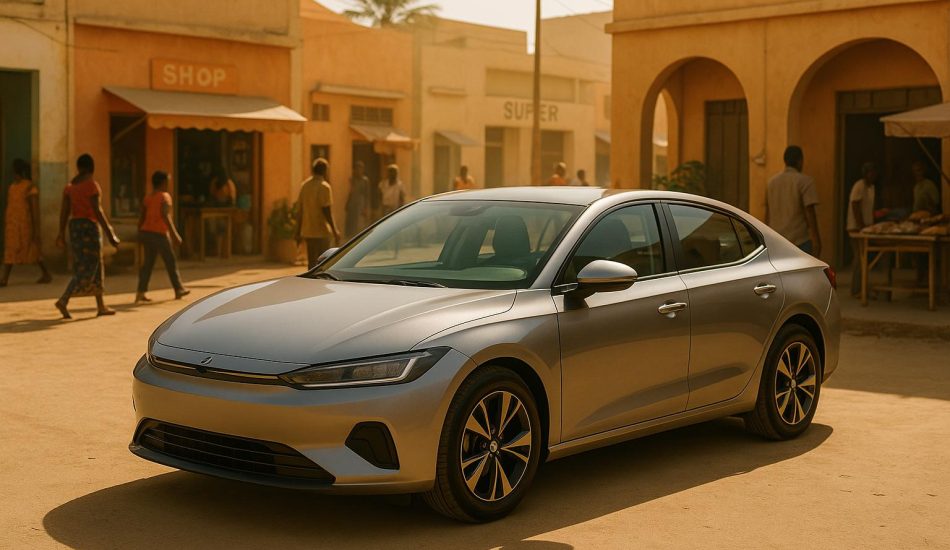
When importing an electric car to South Africa in 2025, it’s all about preparation and understanding the process. Here’s what you need to know:
- Regulations: Only right-hand drive (RHD) vehicles are allowed. You’ll need a Letter of Authority (LOA) from the NRCS and an Import Permit from ITAC before shipping.
- Taxes and Costs: Expect a 25% import duty, 14% VAT, and other fees like luxury tax for high-value cars. Shipping costs range from $1,500 to $2,500.
- Supplier Selection: Work with experienced exporters familiar with South African standards, ensuring compliance with charging ports and safety requirements.
- Shipping and Customs: Choose between container shipping, RoRo, or air freight. Clear customs by submitting accurate documentation and paying duties.
- Final Steps: After customs, pass a roadworthiness test to register the car locally.
Proper planning and compliance with these steps will ensure a smoother import process.
South Africa’s Electric Vehicle Import Regulations
If you’re considering bringing an electric vehicle into South Africa, it’s essential to understand the country’s import rules. These regulations are detailed and must be followed to avoid delays, extra costs, or even rejection at customs. Here’s what you need to know about compliance, costs, and restrictions.
Right-Hand Drive (RHD) and Compliance Standards
In South Africa, vehicles must be right-hand drive to be registered for use on public roads. Left-hand drive vehicles are generally not allowed, except in rare and specific cases.
All electric vehicles must comply with the National Road Traffic Act, 1996, as well as meet SABS standards. Additionally, you’ll need a Letter of Authority (LOA) from the NRCS before importing the vehicle. If you’re importing a used electric vehicle, obtaining an ITAC Import Permit from the International Trade Administration Commission is mandatory before you proceed with the order or shipment.
Import Duties, Taxes, and Incentives
Electric vehicles currently face a 25% import duty in South Africa, which is higher than the 18% duty levied on internal combustion engine vehicles. On top of that, VAT and customs duties are calculated based on the vehicle’s assessed import value.
The government is focusing on boosting local production of electric and hydrogen-powered vehicles, with new incentives set to roll out in March 2026. These incentives include tax deductions for qualifying manufacturers but don’t extend to individual importers. For now, if you’re importing an electric vehicle in 2025, you should plan to pay the full 25% import duty along with any applicable taxes and fees.
Age and Model Restrictions
Beyond meeting technical and compliance standards, it’s also crucial to ensure the vehicle aligns with South Africa’s age and model restrictions. When importing used electric vehicles, confirm that the car meets all safety, emissions, and roadworthiness standards. Restrictions may vary depending on the vehicle’s age and condition, so it’s wise to verify any additional requirements with South African authorities or your supplier. Doing thorough research upfront can save you from facing unexpected issues during the import process.
Calculating Total Costs for Importing an Electric Vehicle
Before importing an electric vehicle, it’s essential to have a clear understanding of all the costs involved. The total expense isn’t just about the purchase price; additional taxes and fees can significantly impact your overall budget.
Breakdown of Taxes and Duties
When bringing an electric vehicle into South Africa, you’ll face several taxes and duties. These include a 25% import duty – notably higher than the 18% duty applied to internal combustion engines from free trade regions like the EU – along with Value Added Tax (VAT), a carbon dioxide tax, and an ad valorem luxury tax, which can go as high as 30% for vehicles priced over $50,000.
The high tax burden on imported EVs has been a point of concern within the industry. Even Elon Musk has pointed out the challenge, referring to South Africa’s "super high" import duties as a major barrier to Tesla’s entry into the market.
Once you’ve accounted for these taxes, the next step is calculating the landed cost.
Estimating Landed Costs
To determine the final landed cost of your electric vehicle, you’ll need to factor in logistics and handling fees. Start with the purchase price, add delivery and customs fees, and then apply the taxes outlined above based on the vehicle’s assessed import value. This comprehensive calculation will give you a better sense of the total cost of importing your EV.
Choosing a Reliable Supplier or Platform
Once you’ve calculated your total import costs, the next big step is finding a trustworthy supplier. Choosing the wrong one can lead to compliance issues, surprise expenses, or even vehicles that can’t be registered due to South Africa’s high import taxes and strict regulations.
Criteria for Selecting a Supplier
Start by checking the supplier’s track record. Look for suppliers with proven experience exporting to African markets, particularly South Africa. Ask for references from previous South African clients and request documentation like business registration, export licenses, and examples of past shipments to South Africa. Reputable suppliers will readily provide this information and are often members of recognized trade associations.
South Africa’s rules on vehicle imports are strict – right-hand drive (RHD) vehicles are mandatory. Left-hand drive vehicles are not allowed for import or registration. Make sure your supplier specializes in RHD models and understands the compliance requirements set by the South African Bureau of Standards (SABS). It’s also essential to confirm that the vehicle supports Type 2 or GB/T charging standards, which are standard in South Africa. Ask for photos of the actual charging port to double-check compatibility.
Transparency is another hallmark of a reliable supplier. They should provide detailed proforma invoices, vehicle specifications, and compliance certificates upfront. Legitimate suppliers will also include vehicle inspection reports and battery safety data sheets without hesitation.
Some of the most popular models from Chinese exporters include the BYD Atto 3, Ora Good Cat, and MG4 EV. These models are well-suited for international markets and come with the necessary compliance documentation, making them reliable choices for import.
Why Use EV24.africa

EV24.africa simplifies the often-complicated process of importing electric vehicles to South Africa. The platform connects buyers to a curated selection of RHD electric vehicles from trusted brands like Tesla, BYD, Volkswagen, XPeng, Leapmotor, Changan, Wuling, Mercedes-Benz, Citroën, and Peugeot.
"Our expertise ensures a seamless, transparent, and stress-free experience, so you can focus on driving the future of mobility." – EV24.africa
By tackling key challenges such as cost transparency and compliance, EV24.africa makes the import process straightforward. The platform offers several advantages, including transparent pricing with no hidden fees, established relationships with compliant suppliers, and full support for everything from customs clearance to local registration. They also handle the extensive documentation process and provide flexible payment options, including financing, to make importing more accessible.
Shipping costs from China to South Africa typically range between $1,500 and $2,500 per vehicle. With EV24.africa’s efficient logistics management, you can save both time and money. They offer both RoRo (Roll-on/Roll-off) and container shipping options, with delivery services extending across all 54 African markets.
Required Documentation to Request
Before making any payments, ensure you have a proforma invoice that includes vehicle specifications, a pricing breakdown, delivery terms, a certificate of origin, and compliance certificates. The certificate of origin is particularly important as it confirms the vehicle’s manufacturing location and its eligibility for any trade agreements.
The vehicle specifications sheet must verify the RHD configuration, charging port compatibility, and technical details required for SABS compliance. Additionally, a certificate of conformity (COC) is needed to prove the vehicle meets international safety standards, while the SABS compliance certificate is critical for South African registration.
For electric vehicles, customs authorities will also require a battery safety data sheet (MSDS). Ensure you have the bill of lading and packing list for shipping and customs clearance. Cross-check that all vehicle details, including the VIN number and model specifications, match across all documents to avoid delays.
SABS certification costs around $2,100 and is valid for two years. Make sure your supplier can either provide this certification or guide you through the process. It’s a good idea to set aside about 3% of the cargo value as a contingency fund to cover unexpected customs delays or additional documentation needs.
sbb-itb-99e19e3
Import and Customs Clearance Process
Importing an electric vehicle into South Africa involves careful planning and adherence to specific steps. Proper preparation can save both time and money.
Import Permit Application and Documentation
Before shipping, you’ll need two critical documents. First, secure a Letter of Authority (LOA) from the National Regulator for Compulsory Specifications (NRCS). Second, obtain an Import Permit from the International Trade Administration Commission of South Africa (ITAC).
To apply for the LOA, complete form LA01. Fees range from ZAR 300 to ZAR 1,800, depending on the type of vehicle. The Import Permit is mandatory for controlled goods and ensures your electric vehicle complies with South African safety and technical standards.
Gather the following supporting documents to complete your application package:
- A copy of your passport
- The vehicle’s license document (e.g., UK V5 or equivalent)
- The LOA
- The Import Permit
Once your documentation is in order, review your shipping options to balance cost and delivery time efficiently.
Shipping Options and Costs
There are three main ways to ship electric vehicles to South Africa: container shipping, roll-on/roll-off (RoRo) shipping, and air freight.
- Container Shipping: A popular choice for its cost-effectiveness, as it allows up to four vehicles per container. Consolidation services can further reduce costs.
- RoRo Shipping: Ideal for operational or oversized vehicles. However, rates and availability may vary.
- Air Freight: The fastest option, with transit times between 3 and 10 days, but also the most expensive.
For shipments from the USA, transit times typically range from 17 to 26 days. Shipping costs include base fees, destination charges, import duties, and cargo protection. Don’t forget to account for South Africa’s 25% import duty and 14% VAT when calculating the total cost.
Customs Clearance and Inspections
Once the vehicle arrives at a South African port, customs clearance and final inspections become the priority. A receiving agent will handle the local arrival process and coordinate clearance. Ensure all your documents, including the LOA and Import Permit, match the supplier’s specifications.
Here’s what to expect:
- Submit the required customs declaration.
- Pay applicable customs duties and VAT to the South African Revenue Service (SARS) unless exemptions apply.
- Receive a Customs Release Notification once payments are complete.
After customs duties and VAT are settled, officials will inspect the vehicle. Once cleared, they’ll issue a release notification, allowing the vehicle to proceed to a roadworthiness test, which is mandatory before registration. To simplify this process, consider working with compliance firms based in Johannesburg, as they can help navigate the clearance process and potentially reduce related costs.
Documentation and Compliance Requirements
Getting your vehicle through South African customs without hiccups requires precise documentation and strict adherence to compliance rules. Missing a step could mean delays, extra fees, or even having your vehicle turned away.
Complete Documentation Checklist
Before you even think about shipping, make sure you’ve secured two key items: the ITAC Import Permit and the NRCS Letter of Authority.
For the ITAC Import Permit, you’ll need to fill out form IE462 and gather the required supporting documents. The specifics of what you’ll need depend on your status – returning citizens and immigrants should refer to the earlier section detailing ITAC application requirements. Alongside this, you’ll also need proof of ownership and a valid vehicle invoice.
The NRCS Letter of Authority is just as critical – it confirms your vehicle complies with South Africa’s safety and environmental standards. Without it, your vehicle won’t pass customs.
When your vehicle arrives, customs declarations and duty payments come next. After clearing customs, you’ll need to complete a roadworthy inspection to finalize the registration process.
Here’s a quick summary of the key documentation required at each stage:
| Stage | Required Documents | Purpose |
|---|---|---|
| Pre-Import | ITAC Import Permit (Form IE462) | Legal authorization for vehicle entry |
| Letter of Authority | Confirms compliance with safety/environmental standards | |
| Proof of ownership & vehicle invoice | Verifies purchase details and legal ownership | |
| Customs Clearance | Customs declaration | Duty and tax assessment |
| Payment receipts for duties | Proof of tax compliance | |
| Post-Arrival | Roadworthy certificate | Final safety check before registration |
These steps ensure a smoother process from pre-import to final registration.
Common Compliance Mistakes to Avoid
Even with all your paperwork in order, mistakes can still happen. Below are some of the most common errors – and how to steer clear of them.
One of the biggest pitfalls? Vehicle specification errors. South Africa only allows right-hand drive vehicles, so importing a left-hand drive vehicle will get it rejected outright. Similarly, electric vehicles that don’t meet the country’s roadworthiness and emissions standards won’t receive the Letter of Authority, leaving you with a vehicle you can’t legally use.
Another frequent issue is inconsistency in documentation. Double-check that details like VIN numbers, model years, and technical specs match exactly across your ITAC application, LOA request, and shipping documents. Even small discrepancies can cause delays.
Returning South African citizens should pay special attention to employment verification. ITAC requires a letter from your employer confirming permanent employment abroad, including specific employment dates. Substituting payslips, contracts, or tax returns instead will lead to a rejected application.
Timing is another area where mistakes can be costly. If you apply for permits after your vehicle has already shipped, you could face steep storage fees at South African ports. Both the LOA and Import Permit must be obtained before the vehicle leaves its origin country.
Finally, don’t overlook financial planning. While ITAC doesn’t charge fees for its services, you’ll still need to pay customs duties. These are calculated as a percentage of your vehicle’s value, so budget for them in advance to avoid surprises during customs clearance.
To minimize risks, work with trustworthy suppliers. Make sure your dealer or platform provides accurate vehicle specifications and all the necessary documentation to meet South African import rules.
Conclusion: Key Steps for Importing an Electric Vehicle in 2025
Bringing an electric vehicle into South Africa in 2025 requires more than just enthusiasm – it demands detailed planning, strict adherence to regulations, and smart decision-making. To navigate this process smoothly, focus on three main areas: regulatory compliance, cost estimation, and supplier reliability.
Regulatory compliance is non-negotiable. Every imported vehicle must meet specific requirements, and all necessary documentation should be in order before shipping. Even a small oversight in paperwork or timing can lead to expensive delays or customs rejection.
Accurate financial planning is essential. The total cost of importing goes far beyond the vehicle’s price tag. Factoring in duties, taxes, shipping, and other fees is critical to avoid budget surprises.
Choosing the right supplier is a game-changer. Partnering with experienced platforms or suppliers ensures access to certified professionals and support throughout the customs process, reducing risks and complications.
The process of importing an electric vehicle to South Africa is evolving, but with careful preparation, it’s entirely achievable. Start early, plan your budget thoroughly, and work with trusted experts to make your dream of owning an electric vehicle a reality.
FAQs
What challenges and costs should I expect when importing an electric car to South Africa in 2025?
Importing an electric car to South Africa in 2025 involves several challenges and expenses that you’ll need to plan for. Import duties are a significant factor, ranging from 18% to 36%, depending on the car’s age, type, and where it’s coming from. On top of that, you’ll face additional taxes like VAT, ad valorem tax, and customs fees.
Shipping costs can also add up, typically falling between $1,200 and $2,500, depending on the distance and shipping method you choose. To comply with South African regulations, you’ll need to secure all the required documentation, such as a Letter of Authority (LOA) and an Import Permit. Paying close attention to these requirements can help you avoid delays and unexpected costs during the import process.
What steps should I take to ensure my electric car complies with South African regulations before importing?
To import your electric vehicle into South Africa while meeting all necessary regulations, you’ll need to follow a few important steps:
- Secure a Letter of Authority (LOA): The National Regulator for Compulsory Specifications (NRCS) issues this document to confirm that your vehicle complies with local standards.
- Check safety and emissions compliance: Ensure the vehicle meets South Africa’s safety requirements and emissions regulations.
- Verify right-hand drive compatibility: Vehicles in South Africa must be right-hand drive to be legally operated on public roads.
By addressing these requirements, you can minimize potential delays and streamline the import process.
What should I consider when choosing a reliable supplier for importing an electric vehicle to South Africa?
When importing a vehicle, it’s crucial to select a supplier who can supply certified documentation – like proof of ECE compliance or a certificate of local origin. These documents confirm that the vehicle aligns with South African standards and import regulations.
It’s also wise to assess the supplier’s reputation. Look into customer reviews, their track record with international shipping, and their expertise in handling customs requirements. A reliable supplier will prioritize clear communication and maintain transparency every step of the way.




